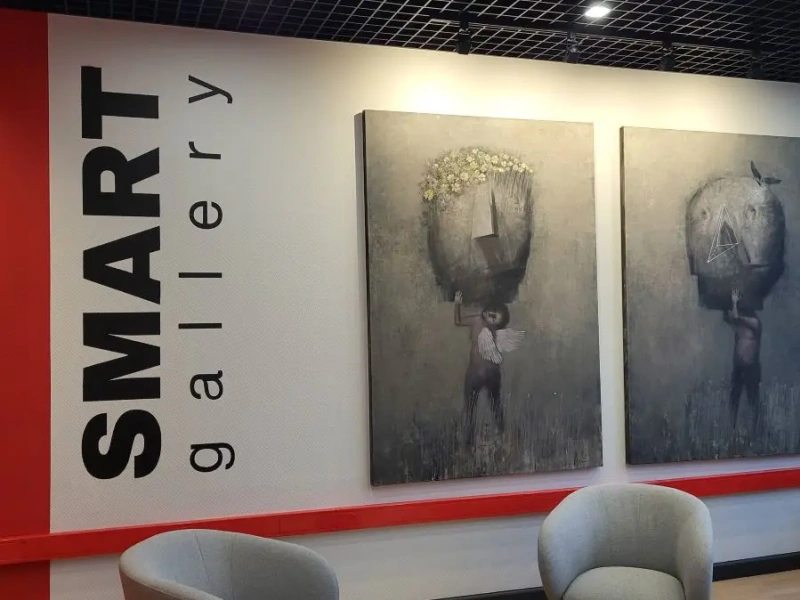In Orbit («На орбите») — масштабный проект художника Томаса Сарацено, входящий в постоянную экспозицию дюссельдорфского музея современного искусства К21. Побывать внутри инсталляции может любой желающий, не страдающий акрофобией — страхом высоты.

Томас Сарацено (Tomás Saraceno, на видео ниже) — художник-исследователь, работающий в жанре сайнс-арта (от англ. science — «наука»). Он родился в 1973 году в Аргентине, изучал искусство и архитектуру в Буэнос-Айресе, Франкфурте-на-Майне и Венеции, а в 2005-м в Германии основал студию, представляющую собой междисциплинарную лабораторию. Сарацено пригласил к сотрудничеству дизайнеров, архитекторов, антропологов, биологов, инженеров, астрофизиков, искусствоведов и музыкантов, чтобы с их помощью реализовать глобальный проект, дело всей своей жизни — создание городов будущего, парящих над Землей.
Урбанистика будущего
Наша планета, уверен художник, находится на пороге экологической катастрофы, вызванной безответственным отношением человека к природным ресурсам. Ей нужно дать отдохнуть и восстановиться, а ее обитателям следует на время покинуть привычную среду и переселиться в новую. Задача Сарацено — создать эту новую среду, которую он решил разместить внутри прозрачных сфер, неподвластных законам гравитации. Томас Сарацено в буквальном смысле витает в облаках и строит воздушные замки, при этом он не считает свои идеи чем-то из области научной фантастики.«Утопии — это то, что заставляет человечество двигаться вперед, расширять границы своих возможностей, — говорит он и цитирует Жюля Верна, — всё, что кажется невозможным сейчас, однажды станет реальностью». Утопия — ключевое понятие для творчества Сарацено: его прекрасный новый мир находится «нигде», у него нет топоса, он подвешен между небом и землей.
Города Сарацено, похожие на скопление мыльных пузырей или облаков, будут свободно дрейфовать в пространстве: лишенные границ и национальных различий, они кардинально изменят образ мира. Воплощать его мечту об урбанистике будущего помогают современные технологии и наука, однако пока что модели городов можно увидеть только в музеях: кураторы называют их интерактивными инсталляциями или парящими скульптурами.

Томас Сарацено. Инсталляция Flying Garden/Air-Port-City, 2005. Центр современного искусства Вилла Манин, Кодройпо, Италия. Источник фото: www.studiotomassaraceno.org
Одним из первых проектов был Flying Garden/Air-Port-City 2005 года в Центре современного искусства итальянского города Кодройпо, в 2012-м на крыше нью-йоркского «Метрополитен» Сарацено построил Cloud City, еще несколько «Облачных городов» возникли в музеях Милана, Сан-Франциско, Гамбурга. Источниками вдохновения для Сарацено являются геодезические купола американского изобретателя Ричарда Фуллера (1895−1983), а также аэростаты, которые, по мнению художника, появились гораздо раньше, чем мы себе представляем, — уже в доколумбовую эпоху.

Томас Сарацено. Инсталляция на крыше Метрополитен-музея, Нью-Йорк, США. Фото: Camilo Brau. Источник фото: www.studiotomassaraceno.org
Эстетика взаимодействия
В футуристичном городе Томаса Сарацено между людьми возникнут новые способы взаимоотношений, и коммуникация представляет для него не меньший интерес, чем архитектура и инженерия. Как истинный утопист, он уверен, что сотрудничество и коллективные действия возобладают над индивидуализмом.Пребывание в прозрачной сфере — это иной телесный опыт, отличный от земного: там невозможно оставаться разобщенными.

Томас Сарацено. Инсталляция Stillness In Motion, Музей современного искусства Сан-Франциско, США. Источник фото: www.studiotomassaraceno.org
Любое движение на нестабильной поверхности физически влияет на другого — каждый шаг должен быть учтен и просчитан. Интерес к возникающим межличностным связям и непременная интерактивность его инсталляций сближает Сарацено с современными художниками, творчество которых французский арт-критик Николя Буррио назвал «эстетикой взаимодействия»: человеческие взаимоотношения являются отправной точкой их практик.
Особое внимание Сарацено уделяет невербальному общению между людьми. Однажды, наблюдая за тем, как паук мгновенно реагирует на муху, оказавшуюся на другом конце паутины, он задумался: могут ли люди одним движением передавать информацию на расстоянии? Поиск ответа повлек за собой серьезное научное исследование: в его студии появилась Arachnid Research Laboratory — лаборатория по изучению паукообразных. Он помещал пауков в прозрачные стеклянные кубы, сканировал паутину, воспроизводил ее из нейлоновых нитей — и пришел к парадоксальному выводу: вселенная устроена как трехмерная паутина, а «архитектура» паутины может стать основой для новых городов. Так возникла идея проекта In Orbit («На орбите»).
Особое внимание Сарацено уделяет невербальному общению между людьми. Однажды, наблюдая за тем, как паук мгновенно реагирует на муху, оказавшуюся на другом конце паутины, он задумался: могут ли люди одним движением передавать информацию на расстоянии? Поиск ответа повлек за собой серьезное научное исследование: в его студии появилась Arachnid Research Laboratory — лаборатория по изучению паукообразных. Он помещал пауков в прозрачные стеклянные кубы, сканировал паутину, воспроизводил ее из нейлоновых нитей — и пришел к парадоксальному выводу: вселенная устроена как трехмерная паутина, а «архитектура» паутины может стать основой для новых городов. Так возникла идея проекта In Orbit («На орбите»).

Террариум в экспозиции, демонстрирующей этапы работы над инсталляцией In Orbit, Музей современного искусства К21, Дюссельдорф, Германия. Фото: Анна Пашина
In Orbit
Под стеклянным куполом дюссельдорфского музея современного искусства К21 из стальных тросов Томас Сарацено «сплел» сеть площадью 2500 м². Похожая и на гигантскую паутину, и на поверхность другой планеты, и на космическую орбиту, инсталляция имеет три уровня и пять наполненных воздухом огромных сфер. Посетители музея могут забраться внутрь: походить между сферами, прилечь на сетку и понаблюдать за людьми внизу, которые с 25-метровой высоты кажутся совсем крошечными.По правилам безопасности, одновременно там могут находиться не более 10 человек старше 12 лет.

Фото: Анна Пашина
Вначале все проходят инструктаж, надевают специальные кроссовки и комбинезоны (их выдает персонал) и оставляют вещи в сейфе. Когда на сетке оказывается несколько человек, возникает вибрация — и каждый участник должен рассчитывать свои движения так, чтобы другой не упал.

Источник фото здесь и ниже: www.kunstsammlung.de
Сарацено работал над созданием In Orbit в течение трех лет в сотрудничестве с инженерами, архитекторами и биологами. Один из залов музея занимает экспозиция, демонстрирующая этапы подготовки проекта. Там же можно увидеть прозрачные террариумы с пауками рода Anelosimus — это так называемые социальные пауки, живущие колониями и плетущие общую паутину.
Автор: Анна Пашина
Автор: Анна Пашина
Главное фото: www.kunstsammlung.de
Рекомендуем почитать






















